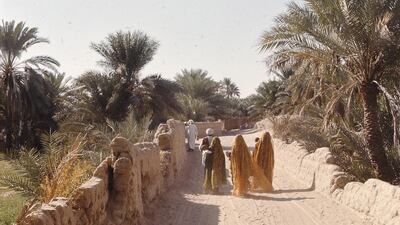Other than the dust kicked up by the strolling figure’s footsteps, Alain Saint-Hilaire’s photograph from 1969 is a study in rural tranquility in which you can almost hear the sound of the women’s conversation and birdsong wafting from the palms.
The strong shadows suggest that the Canadian photographer might have found his subject at the end of a hard day’s work but we don’t know exactly in which of the Al Ain-Buraimi plantations he was exploring and we cannot even be certain which country he was in.
Until November 2006 when controls were introduced and a fence built, the border between Abu Dhabi and the Sultanate of Oman was open. And in the 1960s it was easy to walk between the villages controlled by Abu Dhabi – Al Ain, Al Jahili, Al Qattarah, Al Muwaiji, Al Masoudi and Al Mutaredh – and their Omani neighbours in Buraimi, Sa’ara and Hamasa.
What is certain is that if the image was taken in Al Ain, it also contains the potential to mislead. The men’s clothing and mud brick walls may suggest that the area was a timeless place untouched by modernity.
But the place we now know as the Garden City had been undergoing modernisation since the 1940s when Sheikh Zayed, the Founding President, began rebuilding Al Ain’s irrigation systems during his tenure as the ruler’s representative in the eastern region.
This was followed by the opening of the Oasis Hospital, Al Ain’s first, in 1960 and the first paved motorway between Abu Dhabi and Al Ain, now known as the E22.
Saint-Hilaire not only recorded the new road from the air but also captured the construction of the UAE’s first international hotel, the Al Ain Hilton, which was completed just after this picture was taken and is still welcoming guests.
* Nick Leech


